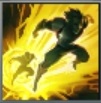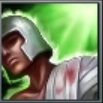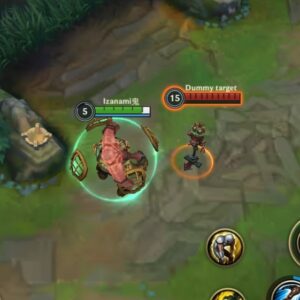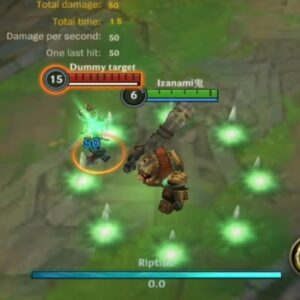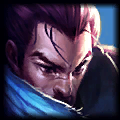Nautilus Wild Rift Build & Guide
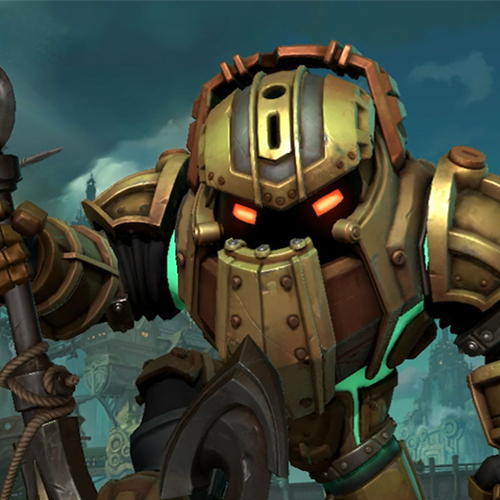
Recommended Builds
None can escape the depths, not with the armored goliath, Nautilus hunting down those who dare to forget to pay the “Bilgewater Tithe”. Nautilus is a tank-support overloaded with several crowd control abilities that can surely put enemies on lockdown before reaching their demise.
Nautilus Wild Rift Build Recommendation
Here are Item Build Recommendations that works on this champion and which are the best build for Nautilus Wild Rift in this patch.
Tanky Titan
This route includes health, armor and damage resistance items necessary for Nautilus to become a lot tankier and survive more teamfights.
Mercury’s Treads or Plated Steelcaps: At the start of the game, purchase and equip Boots of Speed then go for these boots later on. Choosing between these two may depend on the situation and enemy team composition. If most of them scales on AD, pick Plated Steelcaps for armor. If the enemies heavily rely on ability power, pick Mercury’s Tread for magic resistance and tenacity. Tenacity is vital against team compositions overloaded with crowd controls as it reduces the duration of crowd control effects. Overall, this is a great item to purchase first as it is cheaper, grants a shield, armor, damage resistance, and lastly, it boosts your movement speed allowing you to reach your lane faster, or for roaming.
Stoneplate Enchant: provides a decaying shield that absorbs a portion of maximum health. Shield strength will be increased by 100% if there are 3 or more enemies around. Aside from Titan’s Wrath, Nautilus can gain another shield that can take a lot of damage from the enemies.
Dead Man’s Plate: Dead Man’s Plate grants both armor and health that ensures the survivability of Nautilus as a tank on the frontline. Also, Nautilus is initially slow with low base movement speed, but Dead Man’s Plate can be of help with that problem by adding movement speed.
Zeke’s Convergence: This item is a must-have item for tank supports. Aside from armor, magic resistance and mana, Zeke’s Convergence administer a slow field or a blizzard around you slowing down nearby enemies and add burning effects on your allies’ basic attacks enabling them to inflict continuous damage.
Protector’s Vow: For someone who does not have a shield nor a heal to protect his teammates, Protector’s Vow must secure a slot in his inventory. If you or your nearby ally receives damage from any source, Protector’s Vow will get triggered and both of you will obtain a shield that will last for 1.5 seconds. It also grants max health, armor and ability haste.
Warmog’s Armor: Nautilus hinges on armor and health items. Thus, Warmog’s Armor makes a good addition to the list. Warmog’s Armor’s passive will work upon reaching 2,500 maximum health. After getting out of combat, or after receiving no damage for 6 seconds, champions with Warmog’s Armor will restore 5% of health per second. This allows them to heal after getting severe damages then come back again in a teamfight with full health.
Amaranth’s Twinguard: In-combat durability
Thornmail: Provides maximum health and armor. This item is important against fed champions as it reflects magic damage upon getting hit by a basic attack. It is also useful against champions that can heal or self-heal as it applies Grievous wounds. Grievous wounds reduces the healing by a percentage, and increases if immobilized.
Titan's Wrath
If the enemy team consists of heavy AP champions such as Veigar and Ahri, it is necessary to build Magic Resistance items. Magic resistance decreases incoming magic damage that could otherwise lead you to your own death.
Force of Nature: Grants maximum health, magic resistance and movement speed. Also, after taking magic damage, this gives bonus movement speed and bonus magic resistance again which stacks up to 5 times. This is helpful against champions that casts multiple and consecutive magic attacks.
Abyssal Mask: Similar to Force of Nature, it also grants maximum health, magic resistance, mana and ability haste. Aside from a bit of health regeneration and defense stats, Abyssal mask also restores mana equal to a portion of damage taken from opponents.
Runes for Nautilus in Wild Rift
To complete our Wild Rift Nautilus Build recommendation, here is the list of runes to equip before entering in the rift!
Aftershock: Tank supports with heavy crowd controls highly benefits from Aftershock. With a short cooldown, Aftershock provides extra armor and damage resistance upon immobilizing an enemy. Within the duration, Aftershock unleashes a shockwave that scales from your maximum health, and inflicts magic damage to nearby enemies. For Nautilus, it is easy to proc Aftershock as he has 3 crowd control abilities in his kit.
Glacial Augment: A tank with great engage ability is best paired with Glacial Augment, as it slows enemies after landing an engage ability, making it even harder for enemies to disengage.
Weakness: Quite similar to Aftershock, applying crowd control effects to opponents activates Weakness, enabling them to take more damage from all sources. This comes in handy during a teamfight as it makes your target more vulnerable to damage.
Loyalty: Making sure that your carry will not die without getting shields or heals from you, you may pick Loyalty as it will provide bonus armor and bonus magic resistance for you and your nearest ally.
Hunter-Titan: For the resolve rune, Titan focuses more on sustainability. Hunter-Titan initially adds 20 bonus health. For every unique kill participation or unique champion takedown, it continues to add 20 bonus health and 3% tenacity. It can reach 120 bonus health and 15% tenacity upon reaching maximum (5) stacks.
Pathfinder: Pathfinder is the best-in-slot inspiration rune for supports who are fond of roaming as it gives 9% movement speed when in bush, river or jungle. On top of it, Pathfinder also boosts your movement speed when getting out of combat.
Demolish: Can be a good alternative to Pathfinder if your main priority is to take down enemy turrets.
Hunter-Genius: After unique kill participation and unique champion takedown, you will receive a stack of Genius, giving you 3 ability haste. At maximum, you will get 18 ability haste. Ability haste is a stat that directly affects the cooldown of your abilities. With that being said, Nautilus can restrain enemy movements more often with his crowd control abilities.
Spells
Ideally, these are the spells that you will need help you in order to win the game with Nautilus in Wild Rift. Choice of spell however, may depend on the enemy teamcomp.
Flash: For every champion, it is necessary to equip flash at all times and at all situations. Unless of course you’re Yuumi. For Nautilus, Flash is not just an escaping tool and mobility spell that can catch fleeing opponents. Fortunately, it is possible to combine flash to optimize his kit. Combine flash with your Dredge Line to [///] or Flash then root enemies through your passive. Either way, Flash can be used in different combos or strategies that you may want to achieve.
Heal: It is advisable for the duo lane to take barrier-heal or exhaust-heal to improve and ensure their survivability in the laning phase and in teamfights. Heal does not only grant health restoration but movement speed as well.
Other spells that you may equip are ignite or exhaust. Ignite lands on the hands of aggressive players who crave for early lead by defeating the opponents. Likewise, it applies Grievous Wounds to the enemy, reducing incoming healing. Exhaust on the other hand inflicts slow to the target enemy and at the same time decreases their damage.
Skill Order




Enhance Nautilus’ Ultimate Depth Charge as soon as it is available, at level 5, 9 and 13. This way, Depth Charge can be activated more often as it lowers its cooldown by 10 seconds per level. The primary and secondary damage will increase by a large percentage and the stun duration will last longer. For his other abilities, the skill order above is recommended especially with our Wild Rift Nautilus Build. It however might depend on the situation you’re in. Pick his 1st ability, Dredge Line first if you are going for an early aggressive play. It could work well with champions who are relatively stronger in the early game like Lucian. Pairing your passive, Staggering Blow with Dredge Line may grant you a kill. If it’s the other way around, Nautilus and his carry may play passively and have him upgrade his 3rd ability, Riptide first for the slow and at the same time inflict a bit of damage to the enemies.
Starting with his 2nd ability, Titan’s Wrath can also be great option. In terms of trade, you are more likely to survive due to the thick shield that you have gained from it, and don’t forget about the magic damage that you can deal on the enemy while the shield is up.
After that, begin to maximize your Dredge Line first to reduce its cooldown, allowing your team to prey on vulnerable opponents after getting pulled. Afterwards, upgrade Titan’s Wrath for better survivability and lastly, the Riptide.
Abilities

Staggering Blow deals an additional 13 physical damage and roots the target for 0.75 seconds. 6s cooldown on the same target.

Nautilus hurls his anchor forward, dealing 70-250 magic damage (60 + 80% ability power) to the first target hit and pulling them and Nautilus together.
If the anchor hits terrain, Nautilus pulls himself to the terrain and 50% of Drege Line’s cooldown and mana cost are refunded.

Titan’s Wrath grants him a shield that absorbs 138 damage (55 + 10% maximum health) for 6 seconds.
While the shield holds, Nautilus’ attacks are empowered to deal an additional 40 magic damage (40+40% ability power) around the target.
Deal 200% damage against monsters.

Riptide sends waves emanating outward that deal 60 magic damage (60 + 30% Ability power) and slow by 35-50% that decays over 1.6 seconds.
Enemies hit by subsequent waves take 50% damage. Deals 150% damage against monsters.

Nautilus fires a depth charge towards an enemy champion, dealing 150-400 magic damage (150 + 70%). Knocking them up and stunning them for 1 second. Other enemies hit by the Depth Charge are also knocked up and stunned and take 123-225 magic damage (125 + 40% ability power).
Abilities Analysis
Innate Passive | Staggering Blow
Staggering blow allows Nautilus’ basic attack to be empowered, dealing physical damage and rooting the target enemy. Combining this passive along with his abilities got him the ability to become one of most annoying champions to play against due to his chain of crowd control abilities. Being immobilized for a few seconds, it will be easier for Nautilus and his allies to hit their abilities. As for Nautilus, there are other abilities that are waiting to be used; a hook, a stun, slow and a knock up.
His passive however, will not take effect if he’s under the effect of Teemo’s Blinding Dart, Jax’s Counterstrike or spell shields like Morgana’s Black shield.
Q | Dredge Line
Nautilus tosses his anchor forward that inflicts magic damage upon impact, and pulls the target and Nautilus towards each other. Pulling a target reveals the enemy even if they are out of sight or in the bush for instance, but will not be applied to invisible enemies like Evelynn, Akshan and Akali on her shroud. In addition to these, Nautilus can activate his other abilities during Dredge Line.
Unlike Thresh, Blitzcrank and Pyke’s hook, Nautilus’ does not pass through walls. Instead, Nautilus will be pulled towards the terrain similar to Camille’s Hookshot. This can open plenty of opportunities as you can use the Dredge Line in the attempt to catch fleeing enemies or as a means of escape.
Nautilus cannot cast Dredge line if he’s grounded. Also, using this ability against champions with spell shield results to Nautilus getting pulled halfway, while inflicting no effect on the target.
Lastly, knock ups and knock backs can interrupt the Dredge Line and can be stopped even in mid-air.
W | Titan’s Wraith
Nautilus is given a shield that absorbs damage and lasts for 6 seconds. While the shield is up, Nautilus’ normal attack will be empowered allowing him to deal addition magical damage. Aside from Nautilus’ tankiness, Titan’s Wrath also offers another means of protection enabling him to survive multiple damages. The strength of the shield increases per level and relies on his maximum health. To maximize Nautilus’ damage, use Titan’s Wrath after a normal attack to do an autoattack reset.
The empowered attack however, does not work on turrets.
E | Riptide
Nautilus discharges series of waves in a shape of a ring in an outward direction dealing magic damage and inflicting decaying slow to enemies hit. If the target enemy is hit with multiple riptides, they will take 50% less damage from it.
Aside from Nautilus’ hard crowd control abilities, he is also equipped with slows that highly benefits his team. For instance, Riptide can be crucial in preventing enemies from escaping or slowing down enemies who are trying to assassinate your carry.
Another, Riptide offers a good way of clearing the wave due to its damage and area-of-effect damage. Particularly one reason why some players opt to use Nautilus as a jungler.
R | Depth Charge
Nautilus launches depth charge, releasing an underground wave that chases the target enemy, knocking them up and stunning them for a 1-2 seconds. Depth charge travels in a single direction towards the target, also knocking up enemies on the way.
Depth Charge is a point-and-click ability and cannot be dodged, so there’s no need to worry about missing this ability. But if the target is protected by a spell shield or under stasis, it will not hit the enemy. To fully maximize the potential of Depth Charge, try to reach champions at the back. In this way, enemies that are standing in front of your target enemy will be hit as well.
Nautilus Early Game Guide
Supports are expected to accompany the AD carry at the bottom lane during the laning phase. It is not within a support’s role to farm and take resources from minion waves. Instead, try to open kill opportunities with your carry. Due to his pick potential, Nautilus is a terrifying support and has a good early game potential. Use this power to zone the enemy ADC and deprive them of active space. Additionally, Nautilus has a strong level 2 power spike with his 1st and 2nd ability, and the root from his passive.
Keep an eye on the minimap, particularly the side of your jungle. Help your jungler secure the scuttle crab and roam towards mid if possible.
Nautilus Late Game Guide
Nautilus in Wild Rift may not have a shield, heal or other utility that can maintain his allies’ lives, but he has picking and peeling abilities that are crucial in teamfights. Nautilus can engage and obtain important picks to gain lead with Dredge Line and slowing them down with Riptide to prevent any escape. At the same time, he can protect his carry from assassins and bruisers by immobilizing them. Almost everything in Nautilus’ kit can stop them from doing so.
Not least of all, spread wards around the map to gain vision especially on important locations in the map such as the Baron pit and the Dragon pit. At the same time, try clearing off wards using a control ward or oracle lens to deprive them of information.
Synergies
These champions are the best ones to have on your team if you’re playing Nautilus in Wild Rift
Other than his own, Yasuo‘s ultimate, Last Breath counts on other knock up and airborne abilities in order to be casted. Nautilus has two airborne abilities on his kit namely, the Dredge Line and Depth Charge. Upon using these abilities, Yasuo can immediately follow up with his ultimate and other skills, subsequently knocking them up for a longer duration and defeating them at once. Hitting more than one enemy on your ultimate presents better results with Yasuo on your side.
Nautilus has three crowd control abilities in his kit that roots, stuns and knocks up enemies. This is particularly the reason why Nautilus works well with Kai’sa. Kai’sa’s passive, Second Skin grants her stacks of Plasma on her opponents from her basic attacks. Upon reaching 4 stacks of Plasma, the next basic attack will deal bonus magic damage equal to the percentage of the target’s missing health. Additionally, Plasma stacks can be obtained from her 2nd ability, Void Seeker and other immobilizing abilities. With Nautilus’ cc, Kai’sa can immediately gain stacks and deal more damage to the enemies.
Aside from that, Kai’sa can dash from a long distance through her ultimate as long as she has at least one stack of Plasma on an enemy. Hence, after engaging as Nautilus, Kai’sa can immediately position herself.
All Nautilus Wild Rift Counter Champions
At this point, it may be harder to play and use Nautilus if you’re laning against them as they can counter Nautilus’ engages with their abilities. But don’t fret, as there are different ways on how to deal with them. Here are Nautilus Wild Rift counters.
Morgana can turn into a nightmare under the right hands. Landing a crowd control ability on Morgana and her allies can be tough. A well-timed Black shield can block hostile abilities and render it useless. In addition to that, engaging at the worst time may end up getting snared by Morgana’s Dark Binding. Morgana can be countered however by baiting her spell shield. Act as if you are going for the engage by moving aggressive. With that, her spell shield will be on cooldown and it would be easier to engage without worrying about your abilities getting blocked.

Pros & Cons About Nautilus
Here are some pros and cons if you are playing with Nautilus in Wild Rift.
Pros
- An extremely tanky champion that can shield himself with his second ability, Titan’s Wrath
- Nautilus is equipped with heavy crowd control abilities that can lockdown and restrain enemy movements.
- Nautilus in Wild Rift is a tank support that can peel for his carry, allowing them to free-hit from a safe distance.
- He has a good early game potential and can be a threat in the lane.
Cons
- Wild Rift Nautilus moves slowly.
- In relation to the first one, he has no other disengage potential other than his dredge line, which may not be available at all times.
- It is noticeable that Nautilus does not have a shield nor a heal for his allies, hence it will be harder to protect his carry.
FAQ's About Nautilus in Wild Rift
What role / lane should I play with Nautilus in Wild Rift?
Nautilus is originally assigned as a tank support, utilizing his series and chain of crowd control abilities to take over the lane for his carry. Although, some players have been fond of deploying him in the jungle due to quick ganks with his Dredge Line, cc and tankiness.
What is the best runes for Nautilus in Wild Rift?
Nautilus’ best-in-slot keystone for him right now is the Glacial Augment. Glacial Augment works well with Nautilus being tanky and equipped with immobilizing abilities. Upon inflicting root, stun and displacements, it will slow enemies even further thanks to its slow that it provides, leaving enemies harder to disengage once Nautilus has started with his hook ability.
For the runes, it can be weakness, hunter-titan and pathfinder or weakness, loyalty and genius.
What is the best build for Nautilus in Wild Rift?
According to our guide, there are two routes that you may take for Nautilus build in Wild Rift. Prior to the start of the actual game, examine and assess the enemy team composition. If only AD champions make up their team, go for Plated Steelcaps, Dead Man’s Plate, Protector’s Vow, Zeke’s Convergence, Warmog’s Armor and Thornmail. If they are equipped with heavy AP champions with several immobilizing abilities and cc, take magic resistance and tenacity; Mercury’s Treads, Zeke’s Convergence, Protector’s Vow, Force of Nature, Abyssal Mask and Warmog’s Armor.
How good is Nautilus in Wild Rift?
Nautilus is currently at S tier in Wild Rift as he provides multiple and consecutive crowd control abilities, giving the enemies a hard time to get out of it unless they possess a Quicksilver Enchant, Stasis, Spell shields in their inventory. Aside from these, the team benefits well with Nautilus on their side due to his tankiness.
How to land Nautilus' hook in Wild Rift?
The strength and efficiency of a Nautilus player may be judged with his ability to land his hooks and pull enemies. Hence, it is important to practice not missing your hook. The more you miss it, the more you’re losing opportunities to get a kill or a lead. To secure a kill with your hook, work around your space. Think of the best position that will grant you a better view and sight to your target. If there is something that may block your hook like a minion, try to reposition and find a better spot. Next, observe the slightest details in their movement, the direction they are taking for an instance and you might even gain information that is useful in predicting their next move.
If you are not confident with your hook, try to close the gap and place yourself near your target as it is harder to miss your hook if you’re in front of them. You may also commence your combo by rooting them with your passive, Staggering Blow before using Dredge Line to completely immobilize them.
But most importantly, do not throw hooks randomly and impulsively. Only use your hook if you are certain that you’ll hit an enemy.


















